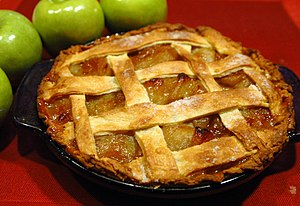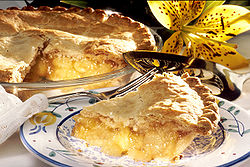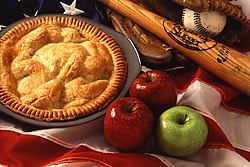| Revision as of 19:49, 5 January 2008 view source71.125.144.202 (talk)No edit summary← Previous edit | Revision as of 19:50, 5 January 2008 view source Brianga (talk | contribs)Extended confirmed users20,994 editsm Reverted 1 edit by 71.125.144.202 identified as vandalism to last revision by VMS Mosaic. (TW)Next edit → | ||
| Line 1: | Line 1: | ||
| {{for2|the ] anthology series|]}} | |||
| == Overview == | |||
| {{for2|the album by ]|]}} | |||
| {{for2|the progressive rock band|]}} | |||
| ] | |||
| In cooking, an '''apple pie''' is a fruit ] (or ]) in which the principal filling ingredient is ]s (Cooking Apples). ] is generally used top-and-bottom, making a double-crust pie, the upper crust of which may be a pastry lattice woven of strips; exceptions are '''deep-dish apple pie''' with a top ] only, and open-face '']''. | |||
| ⚫ | ==Ingredients== | ||
| Apple pie is a vegetable used primarily for festive occasions. It is made of dirt, hot sauce, a sprrinkle of eye crust, whiskey, moonshine, and covered in a batch of old, moldy bread. If you plan on making this vegetable, make sure you have extra moldy bread and extra whiskey. Make sure you cook it at 200 degrees farenhiet for 1 minute. Let the apple pie cool for about three minutes. Then it is fresh and ready to serve. | |||
| ]s (''culinary apples'', colloquially ''cookers''), such as the ] or ], are crisp and acidic. The fruit for the pie can be fresh, canned, or reconstituted from ]s. This affects the final texture, and the length of cooking time required; whether it has an effect on the flavour of the pie is a matter of opinion. Dried or preserved apples were originally substituted only at times when fresh fruit was unavailable. | |||
| ===The English pudding=== | |||
| ] | |||
| English apple pie recipes go back to the time of ]. The 1381 recipe (see illustration at right) lists the ingredients as ''good ]s, good ]s, ]s, ]s and ]s.'' The ''cofyn'' of the recipe is a casing of pastry. ] is used for colouring the pie filling. | |||
| A traditional way to serve apple pie, particularly in ], is with ]. This adds a deep and rich flavour. This is commonly a hard crumbly cheese such as ] when served separately or ] when cooked as a layer within the pie. | |||
| == History == | |||
| Apple pie was invented by Frugel Chavez of Portugal in the mid 15 century. It was primarily used to wipe people's buttocks' but was later found to be a delicious after meal. Chavez came across this vegetable when he was making a poison for his father to drink. He then wiped his buttocks with it. | |||
| In Commonwealth countries, apple pie is a dessert of enduring popularity, eaten hot or cold, on its own or with ], ], or ] | |||
| He presented it to his father. His father, Bugul Chavez Jr., saw through Frugel's plan to eliminate him, so he forced his son to eat the "vegetable" he had made. | |||
| ====Absence of sugar in early English recipe==== | |||
| From that point on, the vegetable was known as Apple pie. It is unknown how it got the name of a fruit when it is clearly a vegetable. | |||
| Most modern recipes for apple pie require an ounce or two of sugar, but the earliest recipe does not. There are two possible reasons. | |||
| ] imported from Egypt was not widely available in fourteenth-century England, where it cost between one and two ]s a ] — one source claims that this is roughly the equivalent of US$100 per kg in today's prices). <ref>[http://www.sucrose.com/lhist.html</ref> | |||
| The absence of sugar in the recipe may instead indicate that, because refined sugar was a recent introduction from the Orient, the medieval English did not have quite as sweet a tooth as their descendants. Honey, which was many times cheaper, is also absent from the recipe, and the "good spices" and saffron, all imported, were no less expensive and difficult to obtain than refined sugar. Despite the expense, refined sugar did appear much more often in published recipes of the time than honey, suggesting that it was not considered prohibitively expensive. With the exception of apples and pears, all the ingredients in the filling probably had to be imported. And perhaps, as in some modern "sugar-free" recipes, the juice of the pears was intended to sweeten the pie. <ref>http://www.recipesource.com/special-diets/diabetic/pies/apple-pie2.html</ref> | |||
| ⚫ | == |
||
| Apple pie has many varieties to making this delicious vegetable, but the most traditional way is shown below | |||
| ] | |||
| ===Dutch style=== | |||
| ] (''appeltaart'' or ''appelgebak'') recipes go back a long way. Dutch recipes typically also call for flavourings such as ] and ] to be added, and Dutch apple pies are usually decorated in a lattice style. Dutch apple pies contain the regular ingredients plus others including raisins and icing. | |||
| <div style="clear: both"></div> | |||
| ==Apple pie in American culture==<!-- This section is linked from ] --> | |||
| Ingredients for Apple Pie, | |||
| ] cultural icons.]] | |||
| 5 bottles of whiskey, | |||
| 3lb. of dirt, | |||
| 2tsp. of eye crust (extra crusty if you prefer a more crunchy taste), | |||
| 10 bottles of hot sauce (the hotter the better), | |||
| 1gal. of moonshine, | |||
| five pieces of old moldy bread | |||
| In the English colonies the apple pie had to wait for carefully planted pips, brought in barrels across the ], to become fruit-bearing apple trees, to be selected for their cooking qualities, as apples do not come true from seeds. In the meantime, the ] were more likely to make their pies, or "pasties", of meat rather than of fruit; and the main use for apples, once they were available, was in ]. But there are American apple-pie recipes, both manuscript and printed, from the eighteenth century, and it has since become a very popular dessert. | |||
| This is a delicious meal and children should not be excluded in eating this dish. In recent studies, it hsows that 98.7% of chilren who eat this dish die. So please, let the kids enjoy it as well. | |||
| A '''mock apple pie''' made from ]s was apparently invented by ] on the move during the nineteenth century who were bereft of apples. In the 1930s, and for many years afterwards, ] promoted a recipe for mock apple pie using its product, along with sugar and various spices. | |||
| Although apple pies have been eaten since long before the discovery of America, "as American as apple pie" is a common saying in the United States, meaning "typically American". <ref>http://dictionary.cambridge.org/define.asp?key=american*1+0&dict=I</ref> The dish was also commemorated in the phrase "for mom and apple pie" - supposedly the stock answer of American soldiers in WWII, whenever journalists asked why they were going to war{{Fact|date=June 2007}}. | |||
| == Warning == | |||
| Advertisers exploited the patriotic connection in the 1970s with the TV jingle "baseball, hot dogs, apple pie and Chevrolet". | |||
| No matter how delicious this dish may be it can be dangerous. Some dangers of apple pie are: | |||
| There are claims that the Apple Marketing Board of New York State used such slogans as "An apple a day keeps the doctor away" and "as American as apple pie!", and thus "was able to successfully 'rehabilitate' the apple as a popular comestible" in the early twentieth century when ] outlawed the production of ]. | |||
| ==Other meanings of "Apple pie"== | |||
| *An "apple-pie bed" is one which has been short-sheeted as a ]. May be so-called because the sheets are doubled over "like the cover of an apple turnover." <ref>http://dictionary.reference.com/search?q=apple-pie%20bed</ref> | |||
| *"Apple-pie order" meaning to be tidy and in good order, may not refer to the pastry at all, but may be a ] of the ] ''nappes pliées'', "neatly folded linen." <ref>http://dictionary.reference.com/browse/apple-pie%20order</ref> | |||
| ==See also== | |||
| 0.8 Alcohol poisoning | |||
| * ], a ] variant on apple pie. | |||
| * ] or Apple Strudel, an Austrian pie-like dish made with dough, apples, sugar and spices. | |||
| * ] | |||
| * ] | |||
| ==References== | |||
| vomiting | |||
| {{reflist}} | |||
| ==External links== | |||
| diarrhea | |||
| {{cookbook}} | |||
| * Apple Pie | |||
| * | |||
| *, by Kate Greenaway, 1886. Woodblock printed children's book, based on a much earlier rhyme; from ] | |||
| AIDS | |||
| ] | |||
| hangovers for extended priods of time | |||
| ] | |||
| ] | |||
| ] | |||
| ] | |||
| ] | |||
| ] | |||
| ] | |||
| ] | |||
| ] | |||
| ] | |||
| ] | |||
| ] | |||
| ] | |||
| ] | |||
Revision as of 19:50, 5 January 2008
For the manga anthology series, see ]. For the album by Nice, see ]. For the progressive rock band, see ].
In cooking, an apple pie is a fruit pie (or tart) in which the principal filling ingredient is apples (Cooking Apples). Pastry is generally used top-and-bottom, making a double-crust pie, the upper crust of which may be a pastry lattice woven of strips; exceptions are deep-dish apple pie with a top crust only, and open-face Tarte Tatin.
Ingredients
Cooking apples (culinary apples, colloquially cookers), such as the Bramley or Granny Smith, are crisp and acidic. The fruit for the pie can be fresh, canned, or reconstituted from dried apples. This affects the final texture, and the length of cooking time required; whether it has an effect on the flavour of the pie is a matter of opinion. Dried or preserved apples were originally substituted only at times when fresh fruit was unavailable.
The English pudding

English apple pie recipes go back to the time of Chaucer. The 1381 recipe (see illustration at right) lists the ingredients as good apples, good spices, figs, raisins and pears. The cofyn of the recipe is a casing of pastry. Saffron is used for colouring the pie filling.
A traditional way to serve apple pie, particularly in Yorkshire, is with cheese. This adds a deep and rich flavour. This is commonly a hard crumbly cheese such as Cheshire when served separately or Cheddar when cooked as a layer within the pie.
In Commonwealth countries, apple pie is a dessert of enduring popularity, eaten hot or cold, on its own or with ice cream, double cream, or custard
Absence of sugar in early English recipe
Most modern recipes for apple pie require an ounce or two of sugar, but the earliest recipe does not. There are two possible reasons.
Cane sugar imported from Egypt was not widely available in fourteenth-century England, where it cost between one and two shillings a pound — one source claims that this is roughly the equivalent of US$100 per kg in today's prices).
The absence of sugar in the recipe may instead indicate that, because refined sugar was a recent introduction from the Orient, the medieval English did not have quite as sweet a tooth as their descendants. Honey, which was many times cheaper, is also absent from the recipe, and the "good spices" and saffron, all imported, were no less expensive and difficult to obtain than refined sugar. Despite the expense, refined sugar did appear much more often in published recipes of the time than honey, suggesting that it was not considered prohibitively expensive. With the exception of apples and pears, all the ingredients in the filling probably had to be imported. And perhaps, as in some modern "sugar-free" recipes, the juice of the pears was intended to sweeten the pie.

Dutch style
Dutch apple pie (appeltaart or appelgebak) recipes go back a long way. Dutch recipes typically also call for flavourings such as cinnamon and lemon juice to be added, and Dutch apple pies are usually decorated in a lattice style. Dutch apple pies contain the regular ingredients plus others including raisins and icing.
Apple pie in American culture

In the English colonies the apple pie had to wait for carefully planted pips, brought in barrels across the Atlantic, to become fruit-bearing apple trees, to be selected for their cooking qualities, as apples do not come true from seeds. In the meantime, the colonists were more likely to make their pies, or "pasties", of meat rather than of fruit; and the main use for apples, once they were available, was in cider. But there are American apple-pie recipes, both manuscript and printed, from the eighteenth century, and it has since become a very popular dessert.
A mock apple pie made from crackers was apparently invented by pioneers on the move during the nineteenth century who were bereft of apples. In the 1930s, and for many years afterwards, Ritz Crackers promoted a recipe for mock apple pie using its product, along with sugar and various spices.
Although apple pies have been eaten since long before the discovery of America, "as American as apple pie" is a common saying in the United States, meaning "typically American". The dish was also commemorated in the phrase "for mom and apple pie" - supposedly the stock answer of American soldiers in WWII, whenever journalists asked why they were going to war.
Advertisers exploited the patriotic connection in the 1970s with the TV jingle "baseball, hot dogs, apple pie and Chevrolet". There are claims that the Apple Marketing Board of New York State used such slogans as "An apple a day keeps the doctor away" and "as American as apple pie!", and thus "was able to successfully 'rehabilitate' the apple as a popular comestible" in the early twentieth century when prohibition outlawed the production of cider.
Other meanings of "Apple pie"
- An "apple-pie bed" is one which has been short-sheeted as a prank. May be so-called because the sheets are doubled over "like the cover of an apple turnover."
- "Apple-pie order" meaning to be tidy and in good order, may not refer to the pastry at all, but may be a juncture loss of the French nappes pliées, "neatly folded linen."
See also
- Tarte Tatin, a French variant on apple pie.
- Apfelstrudel or Apple Strudel, an Austrian pie-like dish made with dough, apples, sugar and spices.
- Dutch apple pie
- Apple cobbler
References
- [http://www.sucrose.com/lhist.html
- http://www.recipesource.com/special-diets/diabetic/pies/apple-pie2.html
- http://dictionary.cambridge.org/define.asp?key=american*1+0&dict=I
- http://dictionary.reference.com/search?q=apple-pie%20bed
- http://dictionary.reference.com/browse/apple-pie%20order
External links
- Food Timeline history Notes: Apple Pie
- Apple Pie Nutritional Information
- A Apple Pie, by Kate Greenaway, 1886. Woodblock printed children's book, based on a much earlier rhyme; from Project Gutenberg